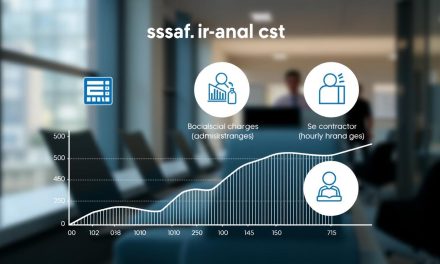When Marc closed his first security retainer, he thought the job was done. A month later a customer called about a repeated phishing issue. Marc tracked the number of incidents, looked at response time, and adjusted his productized phishing simulation. Within three months, client referrals rose and his recurring revenue stabilized.
That simple loop—measure, learn, adjust—captures why focused success metrics matter for a solo practitioner. We will show how business metrics and key performance indicators tie everyday work, like audits and incident response, to clear outcomes.
Our goal is to help you pick a small set of measurements that reflect pipeline health, delivery quality, and customer loyalty. You will learn the difference between outputs (vulnerabilities found) and outcomes (reduced incident rate) so you measure what brings real value.
Table of Contents
Key Takeaways
- Define a handful of success metrics before launching offers to set baselines and targets.
- Prioritize customer success indicators like NPS and CSAT to track trust and referrals.
- Balance revenue signals: recurring contracts vs one‑off gigs for stable business planning.
- Use delivery numbers—response time and first‑contact resolution—to prove reliability to customers.
- Translate findings into product decisions: pricing, retainers, and when to productize services.
Why Success Metrics Matter for Freelance Security Pros Today
Freelance security professionals win when their day-to-day work links directly to measurable business outcomes. That link helps you show value to customers, justify fees, and grow repeat revenue.
Tracking a small set of indicators turns technical tasks—hardening endpoints, tuning SIEM rules, or faster incident response—into proof points for client discussions. Historical data makes choices clearer: if conversions dropped after you removed a free discovery call, you can test and restore it with evidence.
We recommend standard measures like NPS, retention, churn, and CSAT to monitor customer loyalty and the customer experience. These business metrics let you spot onboarding friction early and act before renewals fall.
- Prioritize: pick a few performance indicators that map to revenue and delivery quality.
- Compare: use past baselines to evaluate new product or retainer offers.
- Communicate: quantify reduced incident volume or faster remediation for non‑technical stakeholders.
Defining Business Success Metrics and KPIs in a Solo Security Practice
Map a few practical indicators to daily work so each ticket, patch, or test shows a clear business impact. For a solo security consultant this means converting SaaS labels into service-friendly measures.
Treat retainers like subscriptions to track monthly recurring revenue and treat incidents as timed support events. CAC becomes the real cost to win a new customer across networking, proposals, and unpaid scoping calls.
NPS and CSAT remain useful: run short post-engagement surveys to capture net promoter score and customer satisfaction score after assessments or remediation work.
- Lean scorecard: MRR (retainers), CAC, conversion rate, NPS/CSAT, retention/churn.
- Reframe active users as protected endpoints or covered employees to justify scaling a productized service.
- Define “done” by SLAs met, tickets closed, or risk score improvement so you measure outcomes, not only outputs.
We also recommend pacing rules—set hourly capacity, standard rates, and average engagement length. These simple rules help you forecast workload and keep quality high as your customer base grows.
For growth ideas, consider diversifying your client base to balance recurring income and one‑off projects.
Core Success Metrics You Should Track
Pinpoint the handful of figures that reveal customer satisfaction, retention, and steady income. These indicators help you prove value, price offers wisely, and stabilize cash flow.
Customer satisfaction score (CSAT) after engagements
CSAT is the percentage of « satisfied » and « very satisfied » answers on a 1–5 scale after a test or incident response. Track it as a simple ratio: satisfied respondents ÷ total respondents.
Net Promoter Score (NPS) to gauge loyalty and referrals
Ask the standard 0–10 question. Calculate NPS as promoters (9–10) minus detractors (0–6). Always collect a short « why » to turn numbers into fixable feedback.
Customer retention rate and client churn rate
Retention compares customers at period end versus start. Churn rate is the inverse and flags onboarding or value issues early. Segment by retainer tier: lower tiers often show higher churn.
Customer lifetime value from retainers and repeat projects
Estimate customer lifetime by combining average retainer, renewal probability, and typical relationship length. Use this lifetime value to set pricing and decide where to invest time.
Monthly recurring revenue from maintenance contracts
For services, MRR = average retainer value × active retainers. Monitor MRR trends to forecast capacity and tie changes to specific delivery or marketing actions.
- Practical tip: run a short post‑project survey cadence so CSAT and NPS are comparable month to month.
- Keep a single‑page dashboard that tracks score, rate, value, and revenue monthly to stay focused without overanalysis.
Acquisition and Conversion: From Leads to New Customers

We advise you to track cost, conversion, and volume as linked indicators. For a solo security consultant, clarity here protects your time and improves return on outreach.
Customer acquisition cost across channels
Calculate customer acquisition cost as total sales and marketing expenses divided by new customers in the period. Include ads, sponsorships, tooling, and the hours you spend on proposals and scoping.
Lead-to-client conversion rate for proposals
The lead-to-client conversion rate reveals pipeline quality. Standardize proposals, add brief discovery calls, and use targeted case studies to raise the acceptance rate.
Total number of new customers per period
Track the total number of new customers monthly or quarterly to validate growth pace. Compare channels by acquisition cost to double down on high-yield sources like MSP partnerships.
| Indicator | How to calculate | What to track |
|---|---|---|
| Customer acquisition cost | Total spend ÷ new customers | Channel split, hours, tool fees |
| Lead-to-client conversion rate | Clients won ÷ qualified leads | Proposal template, discovery calls |
| Total new customers | Count per month/quarter | Source, service type, time-to-close |
- Qualify leads with a short intake form to protect your time and lift conversion.
- Measure time-to-close by product; shorter cycles often mean clearer offers you can scale.
- Use a simple CRM to store source, stage, and notes so your pipeline stays decision-ready.
Delivery and Productized Service Performance Indicators
Delivering reliable, repeatable service hinges on clear delivery signals you can measure and improve. Those signals show clients you meet commitments and help you price and scale a product service fairly.
Incident response time and first-contact resolution
Track incident response time from alert to first action. Set SLAs that match your on‑call model and state them in contracts.
First Contact Resolution (FCR) counts when a support request is closed on the initial interaction. Define what « first contact » means for each request type so reporting stays consistent.
Uptime and availability in SLAs
Define uptime commitments for managed components like monitoring dashboards or patch orchestration windows. Monitor adherence and publish simple availability reports to customers.
Average engagement duration and utilization rate
Record average engagement length by service line to improve scoping and fixed‑fee pricing. Track utilization rate to balance delivery, sales, and admin work.
- Use a standard playbook (triage, containment, eradication, recovery) and time each phase to find training gaps.
- Count incidents per client and per protected asset to surface hotspots for targeted hardening.
- Score post‑incident reviews so lessons update controls, docs, and client education.
- Tie delivery indicators back to revenue by correlating fast response and high FCR with renewals and upsells.
- Capture light telemetry—tickets, timestamps, outcomes—so reporting is defensible without heavy tooling.
For a practical start, combine these delivery indicators into a simple sheet and track performance with Google Analytics or a lightweight dashboard. This keeps the team focused and customers informed.
Customer Experience and Engagement Signals

Gathering direct customer feedback reveals the hidden friction that numbers alone cannot show.
Qualitative customer feedback explains why a satisfaction score rose or fell. Short open fields after an assessment or onboarding let you read exact pain points. These comments can be parsed with simple text analysis or reviewed monthly by you.
Qualitative customer feedback to uncover friction
Collect a one‑sentence comment after each delivery. Ask what was easy and what caused delay.
- Why it helps: open answers point to handoff issues, unclear deliverables, or tool access problems.
- Map themes to a fix list and assign simple actions you can complete in a week.
- Share a short monthly note on « what we improved » to build customer loyalty and invite dialogue.
Customer Effort Score during onboarding and support
Use Customer Effort Score on a 1–7 scale after onboarding or support. Report the percentage of positive responses to spot friction quickly.
« We reduced onboarding effort by automating access provisioning, and renewals rose the next quarter. »
| Signal | When to collect | Action |
|---|---|---|
| Open feedback | Post‑delivery, 24–72 hours | Tag themes, assign fixes, respond publicly |
| Customer Effort Score (CES) | After onboarding and key support tasks | Simplify steps with automation, measure change |
| Promoter score + comment | Quarterly or post‑project | Ask one follow‑up: « Why? » Use advocates for references |
Keep surveys one question long and focused. Pair CES with net promoter or a short promoter score comment to link ease of use with advocacy.
Segment responses by client type (SMB vs mid‑market), note time‑to‑value, and close the loop with thank‑you notes and visible fixes. Training templates and checklists help a solo team respond quickly and consistently.
For deeper reading on quality and engagement, see our short guide on quality of delivery and expert engagement.
Revenue Quality and Stability Metrics
Quality of revenue matters as much as quantity when you run a one‑person security practice. Monthly Recurring Revenue (MRR) supports planning and shows growth momentum. Use it to forecast capacity, hiring, or buying tools.
Recurring revenue vs. one‑off project mix
Balance retainers and one‑off work to smooth cash flow. Retainers give predictable revenue; ad‑hoc projects boost short‑term income.
Tip: Set minimum retainer scopes so each recurring product delivers clear value and avoids scope creep.
Net dollar retention across retainers
Calculate Net Dollar Retention (NDR) to see how existing customers change your revenue:
(Starting MRR + expansion – downgrades – churn) ÷ Starting MRR × 100
Track this rate by tier and industry to spot where customers expand or shrink. Tie renewal risk to delivery signals like missed SLAs so you can act before contracts lapse.
- Track customer retention and renewal terms to test revenue durability.
- Segment by industry and product tier to prioritize outreach for expansion.
- Keep a simple revenue calendar with renewals, projected expansions, and likely churn.
| Indicator | How to calculate | Why it matters |
|---|---|---|
| MRR | Average retainer × active retainers | Plans cash flow and investment timing |
| Recurring vs one‑off mix | % recurring revenue ÷ total revenue | Shows stability and hiring capacity |
| Net Dollar Retention | (Start + expansion – downgrades – churn) ÷ Start ×100 | Measures growth from existing customers |
| Renewal rate | Renewals ÷ contracts up for renewal | Predicts revenue durability |
How to Measure and Benchmark Your Metrics
Begin by anchoring each number to a clear business question: what does this change tell you about revenue or retention?
Setting baselines, targets, and review cadences
Start with three months of history when possible. Use that as your baseline and set quarterly targets.
Review numbers monthly with a short checklist. Keep the review under 30 minutes so it remains a habit.
Simple formulas for common indicators
| Indicator | Formula | Use |
|---|---|---|
| CAC | Total sales & marketing spend ÷ new customers | Cost to win a customer |
| Lifetime value (CLV) | ARPA ÷ churn rate OR avg purchase × freq × customer lifetime | Forecast revenue per customer |
| Retention / churn rate | Retention = end ÷ start; Churn = 1 − retention | Health of your book of business |
| Net Promoter / NPS | % promoters − % detractors | Advocacy and referral potential |
| CSAT | Satisfied respondents ÷ total respondents × 100 | Immediate post-engagement score |
Interpreting trends to make data-driven decisions
Favor trends, not single points. Use moving averages to remove noise.
Segment by industry or tier to spot where your offer fits best. Set simple thresholds: a low NPS or rising customer churn rate triggers a follow-up within 48 hours.
- Pick three total number KPIs (new clients, active retainers, avg resolution time).
- Triangulate numbers with short customer feedback to explain large shifts.
Tools and Workflows to Operationalize Success Metrics
Practical workflows help you capture customer feedback and turn it into product changes fast.
Choose a lightweight CRM (HubSpot free or Notion templates) to track pipeline stage, source, and a field for acquisition cost. This keeps customer records tidy and reduces admin time.
Lightweight CRM, survey, and time‑tracking stack
Send automated microsurveys after engagements and quarterly for retainers with Typeform or Google Forms. Tools like Userpilot let you run in‑app prompts; the same idea works for service workflows.
Track time with Toggl or Harvest to calculate utilization and refine fixed‑fee product estimates. Centralize customer feedback and promoter score comments so themes are visible.
Automated surveys to calculate NPS and CSAT
- Automate CSAT and net promoter score sends after delivery to keep response rates high.
- Store results in a Google Sheet or Data Studio view to avoid heavy SaaS companies tooling costs.
- Tag tickets by service type in your PM tool to connect effort and outcomes for each product line.
| Tool | Purpose | Benefit |
|---|---|---|
| HubSpot / Notion | CRM & pipeline | Track acquisition cost and customer source |
| Typeform / Google Forms | Surveys (CSAT, NPS) | Automated score and comment capture |
| Toggl / Harvest | Time tracking | Improve estimates and utilization |
| Google Sheets / Data Studio | Dashboards | Low‑cost visualization for team reviews |
Conclusion
Keep a small dashboard of numbers that prompt one actionable change each month.
Choose a focused set of success metrics that map to acquisition, delivery, and renewal. Track CAC, MRR, NPS, CSAT, retention, churn, and CLV with simple formulas.
With a monthly review you turn each number into a decision: fix onboarding friction, tighten SLAs, or adjust a product price. This links technical work to clear business value and steadier revenue.
Make reviews short, keep tools lean, and ask one question after each delivery so customer success grows into real loyalty and referrals.
In short: clear definitions, steady cadence, and one improvement per metric make your freelance practice more resilient and predictable through focused metrics.
FAQ
What are the most important success metrics for a freelance security consultant?
Focus on customer satisfaction score (CSAT), Net Promoter Score (NPS), customer retention and churn rate, customer lifetime value (CLV), and monthly recurring revenue (MRR). These indicators show client happiness, loyalty, revenue stability, and long-term value from retainers or repeat work.
How does NPS differ from CSAT and when should I use each?
NPS measures loyalty and likelihood to recommend, useful for assessing referrals and advocacy. CSAT captures immediate satisfaction after an engagement or support interaction. Use CSAT for tactical improvements and NPS for strategic growth and client sentiment over time.
How do I calculate customer acquisition cost (CAC) as a solo practitioner?
Add marketing and sales spend for a period (ads, tools, subcontractors, your tracked hours for outreach) and divide by the number of new customers acquired in that period. Keep the formula simple and track channel-specific CAC to prioritize effective channels.
What is a practical way to measure churn rate for my freelance security business?
Churn = (lost clients during period) ÷ (clients at start of period). Measure monthly or quarterly depending on your engagement cadence. Track reasons for churn to guide retention efforts and reduce lost revenue.
How can I estimate customer lifetime value (CLV) for retainers and repeat projects?
Multiply average revenue per client by average client lifespan (in months or years), then adjust for gross margin and retention rate. For retainer clients, use their monthly recurring revenue and expected retention period to get a reliable CLV.
Which KPIs translate well from SaaS to service-based security work?
Useful SaaS KPIs for services include MRR, churn, CLV, CAC, and NPS. Translate product usage metrics into service analogs: engagement frequency, incident response time, and average engagement duration. These reveal revenue health and service effectiveness.
What day-to-day activities should I align with measurable client outcomes?
Prioritize timely incident response, clear onboarding steps, consistent reporting, and proactive security reviews. Track first-contact resolution, response SLAs, and client feedback after each milestone to link operations to outcomes.
How do I benchmark incident response time and first-contact resolution?
Record timestamps for ticket or request receipt, first response, and final resolution. Set baseline targets (for example, first response within 4 hours) and compare against historical averages. Use these benchmarks to refine SLAs and staffing plans.
What metrics indicate the quality and stability of my revenue stream?
Monitor the ratio of recurring revenue to one-off project income, net dollar retention across retainers, MRR growth, and customer churn. A higher share of recurring income and positive net dollar retention signal greater stability.
How often should I review and report these indicators?
Adopt a cadence that matches your business rhythm: weekly for operational items (tickets, response times), monthly for financial KPIs (MRR, CAC, new customers), and quarterly for strategic measures (NPS, CLV, retention trends).
What simple formulas should I keep handy for quick calculations?
Key formulas: CAC = total acquisition cost ÷ new customers; Churn rate = lost customers ÷ starting customers; CLV ≈ average revenue per client × average client lifespan; NPS = %Promoters − %Detractors; CSAT = average satisfaction score after engagements.
Which tools are lightweight but effective for tracking these indicators?
Use a simple CRM (HubSpot free or Pipedrive), a survey tool for NPS/CSAT (Delighted, Typeform), and time-tracking (Toggl, Clockify). Combine with a spreadsheet or BI-lite tool to consolidate revenue and churn calculations.
How can I collect useful qualitative feedback without annoying clients?
Send short, targeted surveys after key interactions, ask one open question about friction points, and schedule occasional 15‑minute check-ins with strategic clients. Keep communications brief, value-focused, and timed around project milestones.
What is a realistic target for customer retention and net promoter score?
Targets vary by niche, but aim for high retention (low single-digit monthly churn) and an NPS above 30 as a baseline. Use these targets as guides and adjust based on client size, contract length, and service complexity.
How do I interpret trends when metrics move in opposite directions?
Drill into segment data. For example, rising MRR with higher churn may indicate growth from one-off sales but poor retention. Cross-check NPS, CSAT, and qualitative feedback to find root causes and prioritize fixes.
Can automated surveys reliably calculate NPS and CSAT for a solo operator?
Yes. Automated tools can trigger surveys after onboarding, ticket closure, or monthly intervals. They save time and produce consistent data. Combine automated scores with occasional personal follow-ups for richer insight.
How many new customers per period should I aim to acquire?
Targets depend on your capacity and pricing. Define a goal based on desired revenue growth and utilization. For example, if you want 20% growth, calculate how many new retainers or projects at your average price achieve that, then track conversion rates to know required leads.





